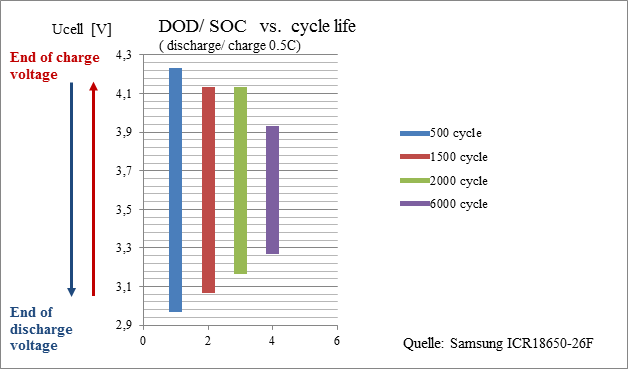Examination and assessment of lithium-ion battery life

This consideration is an important aspect not only for direct application, but also for the definition of service intervals, and last but not least for storage. The life of a battery pack is determined essentially by two factors: Cyclical and calendrical aging. This paper provides an overview of these two aging processes and their significance.
Service life factors of battery packs
The service life of a battery pack is defined by the cyclical life (how often can a battery be charged and discharged?) and the calendrical life (how much capacity does the battery lose due to aging effects?). In general, with regular use of the application, the number of cycles determines the end of life of the battery because charging and discharging processes damage the battery faster than aging processes.

Life span of a lithium-ion battery pack
Data sheets of the cells used provide the first clues as to the life span of a battery pack. Here you will find information on the number of cycles and storage, which can only serve as first indicators of the actual life: Especially the number of cycles indicated in the data sheets depends on a variety of marginal and side conditions, which often deviate from the real operating conditions of the specific application.
Factor 1: Cyclical aging
Cyclical aging describes the proportion of aging that results from the battery use (repeated charging and discharging). This can be attributed to chemical and mechanical wear effects, including, for example, thermal expansion or dendrite growth. For cyclical aging, the depth of discharge is a crucial factor. A deep discharge stresses the material chemically and mechanically, reducing the number of possible cycles. This correlation, however, is not linear, so halving the depth of discharge can double the number of possible cycles.
With a depth of discharge between 90 % and 100 %, the cyclical aging is particularly high, which is why this area is used only in exceptional cases. Generally, applications work at discharge depths of ≤ 90 %.
In addition to a limited depth of discharge, the number of possible cycles can also be influenced by regulating the end-of-charge voltage. Thus limitations of the charging voltage to a value below the nominal charge end voltage can double the number of cycles.

Dependence of the cyclical life on the charging level and discharge of a Li-ion cell
The amount of charging currents is an important aspect for determining and influencing the service life. Due to time savings, in practice, a quick charging method is used. The charging current is often a multiple of the standard charging current specified in the data sheet, which leads to a drastic reduction in the number of cycles in a consistent use of the quick charging process due to the higher thermal and mechanical stress on the cells. FRIWO’s measurements show that charging with 1C instead of 0.5C nearly halves the cyclical life.
Cyclical aging therefore depends significantly on the application and battery use. The more accurately the load conditions of the application can be modeled, the more precisely the cyclical aging can be investigated and estimated by means of long-term measurement.
Factor 2: Calendrical aging
With increasing cell age, chemical deterioration processes start which can attack the electrolyte as well as anode and cathode materials. The concomitant loss of capacity is described by the second aging mechanism: the so-called calendrical aging. Decisive factors for this decay process are the charging state of the cells and the ambient temperature. According to the “RGT rule” (reaction rate temperature rule, also known as van ‘t-Hoff’s rule) the calendrical life is halved at a temperature increase of 10 K. The following arithmetic example is meant to exemplarily depict a possible estimate of calendrical aging. As a first approximation, a linear approach can be chosen.
A cell manufacturer reports a 90 % recovery for his cell after 1.5 years in a temperature range of -30…25°C. According to the manufacturer, the official end of life reads 60 %. This suggests a theoretical service life in conjunction with calendrical aging if the cell is stored according to the specifications: with 10 % capacity loss per 1.5 years, a total of six years elapse until the final value of 60 % is reached. However, in reality, this theoretical life will be reduced due to the cyclical aging and application, which will ultimately be less than six years.
The specific cyclical aging of a rechargeable battery can be investigated and estimated by FRIWO on the basis of load profiles. Considering the calendrical aging, a realistic service life estimation of the battery pack is thus possible.
For more information about FRIWO and our products & services, click here.
Tags: FOX30-C, FOX40-C, Medical charging technology, IEC60601-1, Medical Power Supplies, 2 x MOPP, IEC60335-2-29